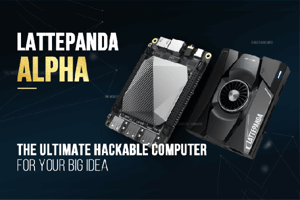
Tiny, cheap computers are exploding in popularity
While most PC segment sales have been stagnant or dropping, the sales of Single Board Computers (SBCs) are booming, with estimated sales expected to reach $1.7bn AUD by 2024.
Single Board Computers don’t come with monitors, keyboards, mice or even a case – their intended use is much more flexible than a typical desktop PC. SBCs are inexpensive, simple computers on a single silicone circuit board with integrated technology – usually a low-power CPU, RAM & Flash memory for storage, Wi-Fi and/or Bluetooth, and a range of Input/Output (I/O) connectors.
"The Raspberry Pi was released in 2012 at a cost of under $50 AUD, with expected sales of under 1000 units. So far over 19 million have been sold."
LattePanda Alpha release brings serious Windows computing to SBCs
With the release of the LattePanda Alpha, we now can buy a PC the size of a wallet that can out-perform a MacBook Pro at a fraction of the cost.
The Alpha costs $700 AUD when bundled with Windows 10 Professional. It ships with an Intel m3 CPU, 8GB of RAM, 64GB of super-fast eMMC storage and a GPU. The "AlphaPanda" benchmarks above the latest MacBook Pro M3. The price differences relate to pre-order incentives and the level of Windows licence being purchased.
A key feature of the LattePanda range is its Arduino Input/Output interface, opening up a huge range of existing and inexpensive plug-in circuit boards and sensors. Many of the sensors and peripherals in the “maker” market are designed to work with Arduino.
There’s a backstory here about these tiny computers with quirky names.
It started with the Raspberry Pi
In 2012 the Raspberry Pi revolutionised the IT and electronics world. It was a PC on a single silicon board running Linux. The cost of the Raspberry Pi has remained steady throughout their model updates at around $60 in Australia. The Raspberry Pi is now one of the world's best-selling computers, and a large number of offshoot products have started their own revolutions, such as the Arduino and Pycom SBCs.
What has been missing so far has been an SBC powerful enough to run Windows's x86 Intel architecture. With the launch of the LattePanda products, this has changed.
The latest version is their most powerful, called the "AlphaPanda" and it costs up to $700 AUD when bundled with Windows 10 Professional. The Alpha ships with an Intel m3 CPU, 8GB of RAM, 64GB of super-fast eMMC storage and a GPU. The AlphaPanda benchmarks above the latest 12-inch MacBook. The price differences relate to pre-order incentives and the level of Windows licence being purchased.
A key feature of the LattePanda range is its Arduino Input/Output interface, opening up a huge range of existing and inexpensive plug-in circuit boards. Many of the sensors and peripherals in the “maker” market are designed to work with Arduino.
How can a PC with no case, no display or even a power supply be so popular?
SBCs don't come with a keyboard, a mouse, or even a display - though they can be used with all of these peripherals.
They're most popular with the booming "maker" community, who utilise these tiny computers for small tasks where a full PC is too big or too expensive, often in "set and forget" use cases. Real world examples include monitoring levels on LPG tanks, recording and reporting on river water quality in remote areas, spying on our pets and in home-brew beer temperature monitoring.
With their very low power requirements, these PCs make realistic the possibility of being "off-grid" and using only battery and renewable power. These attributes tie the SBCs closely with the Internet of Things (IoT) market.
IoT and the flexible use of Single Board Computers
The emergence of SBCs has been linked to their popularity with “maker" community, because they provide an accessible platform to use existing technology to perform small tasks at a small scale. Popular “hackathon” events are held worldwide, showcasing the creative and innovative use of this technology.
SBCs have been embraced by more than enthusiasts, however, with devices like the LattePanda providing big business with an off-the-shelf platform that can be used to implement a solution to market in a very short development cycle.
Currently the humble PC runs many of our day-to-day tasks, such as ATMs, point-of-sale cashier machines, and information displays at shopping centres and airports.
Will this latest SBC innovation be the PC of our future, working behind the scenes to keep our modern world ticking? Will they revolutionise the developing world where electricity and telecommunications infrastructure is minimal or non-existent?
LattePanda’s AlphaPanda and DeltaPanda could be the PC of the future in more ways than we can imagine.
References
Photo from Kickstarter LattePanda Alpha campaign:
https://www.kickstarter.com/projects/139108638/lattepanda-alpha-soul-of-a-macbook-in-a-pocket-siz
Data collated from the following:
https://www.lattepanda.com/
https://www.techrepublic.com/article/size-of-a-raspberry-pi-power-of-a-macbook-the-window-10-powered-lattepanda-alpha/
https://www.prnewswire.com/news-releases/single-board-computer-market-to-hit-12bn-by-2024-global-market-insights-inc-614461033.html
https://core-electronics.com.au/electronics-blog/lattepanda-alpha/
How can Diamond help?
Diamond IT keeps up-to-date with the latest technology so you don't have do.
Our consulting team can assist with your current and future needs, setting strategies, policies and procedures to make the most of your technology investments.
Give us a call on 1300 307 907 or contact us via the form below.




